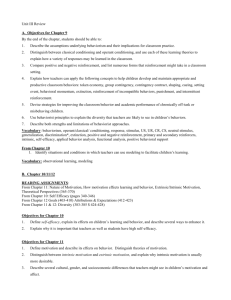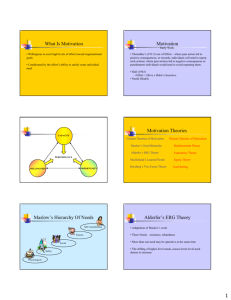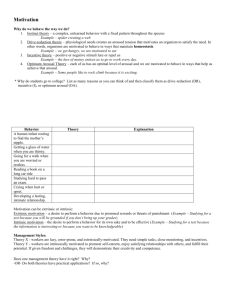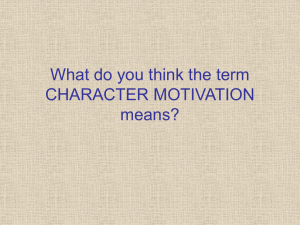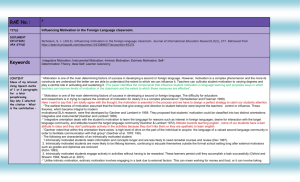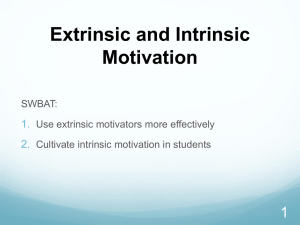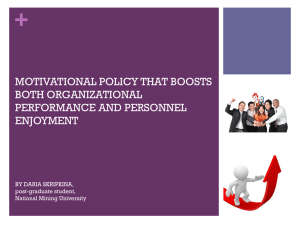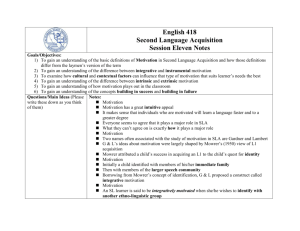Engagement_overview
advertisement
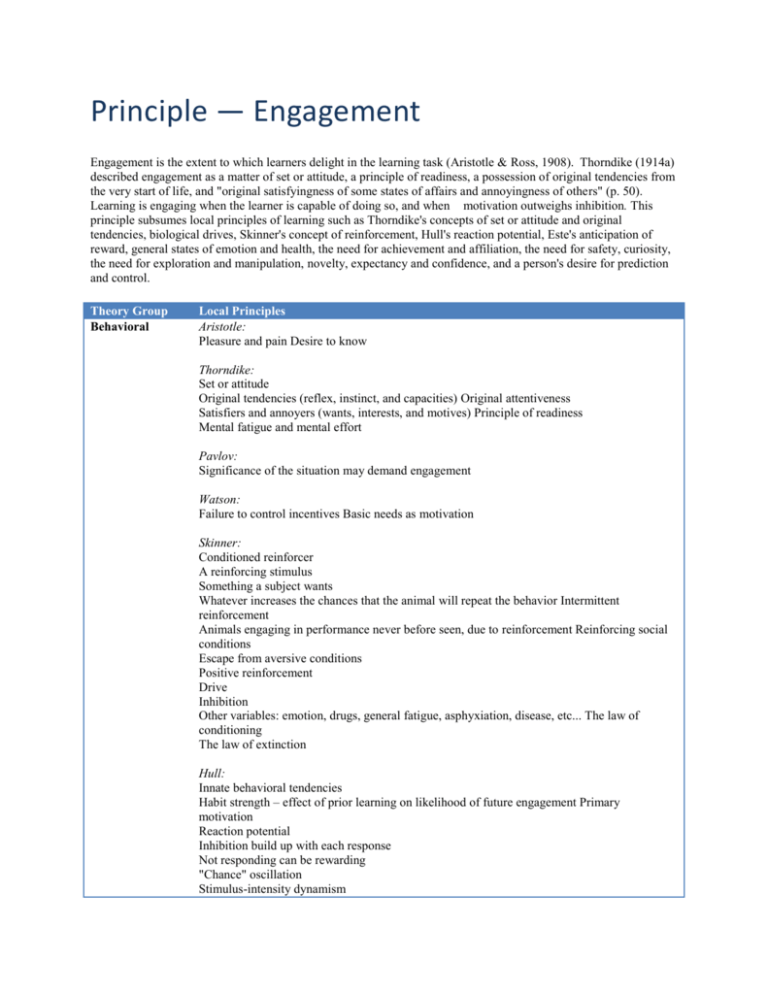
Principle — Engagement
Engagement is the extent to which learners delight in the learning task (Aristotle & Ross, 1908). Thorndike (1914a)
described engagement as a matter of set or attitude, a principle of readiness, a possession of original tendencies from
the very start of life, and "original satisfyingness of some states of affairs and annoyingness of others" (p. 50).
Learning is engaging when the learner is capable of doing so, and when motivation outweighs inhibition. This
principle subsumes local principles of learning such as Thorndike's concepts of set or attitude and original
tendencies, biological drives, Skinner's concept of reinforcement, Hull's reaction potential, Este's anticipation of
reward, general states of emotion and health, the need for achievement and affiliation, the need for safety, curiosity,
the need for exploration and manipulation, novelty, expectancy and confidence, and a person's desire for prediction
and control.
Theory Group
Behavioral
Local Principles
Aristotle:
Pleasure and pain Desire to know
Thorndike:
Set or attitude
Original tendencies (reflex, instinct, and capacities) Original attentiveness
Satisfiers and annoyers (wants, interests, and motives) Principle of readiness
Mental fatigue and mental effort
Pavlov:
Significance of the situation may demand engagement
Watson:
Failure to control incentives Basic needs as motivation
Skinner:
Conditioned reinforcer
A reinforcing stimulus
Something a subject wants
Whatever increases the chances that the animal will repeat the behavior Intermittent
reinforcement
Animals engaging in performance never before seen, due to reinforcement Reinforcing social
conditions
Escape from aversive conditions
Positive reinforcement
Drive
Inhibition
Other variables: emotion, drugs, general fatigue, asphyxiation, disease, etc... The law of
conditioning
The law of extinction
Hull:
Innate behavioral tendencies
Habit strength – effect of prior learning on likelihood of future engagement Primary
motivation
Reaction potential
Inhibition build up with each response
Not responding can be rewarding
"Chance" oscillation
Stimulus-intensity dynamism
Incentive motivation
Delay in reinforcement
Guthrie:
External interest shown in performance results in engagement Intention to accomplish
something
Advertant and inadvertent responses
Intense stimulation
Accumulated effects
Interference
States of excitement intensify action and bring new stimulation
Motives: stimulus situations that keep the individual active until some specific goal
is reached
Cognitive
Estes:
Anticipation of reward
"Effective" stimulus elements
Motivation affects the composition and magnitude of the effective stimulus elements
Ebbinghaus:
Attention and interest
Tolman:
Purpose
Kohler:
Improvement of the objective
Cognitive Information Processing:
Interest
Level of difficulty or effort
Ausubel:
Perceived need
Motivation
Drive reduction (human learning rarely motivated by drive reduction) Material rewards vs.
intrinsic rewards
Achievement motivation
Cognitive drive
Affiliative drive
Ego-enhancement motivation
Much learning is neither energized by motivation nor reinforced by drive satisfaction It is
misleading to apply homeostatic drive reduction to human learning
Relative ineffectiveness of homeostatic or material rewards in human learning
Constructive
Schema Theory:
Need: when a schema is sufficiently poor at describing the situation, a new schema must be
sought
Discrepancy
General:
Student responses drive lessons, shift instructional strategies, and alter content
Student inquiry
Natural curiosity
Posing problems of emerging relevance
What and how much is learned is influenced by motivation—emotional states,
beliefs, interests and goals, and habits of thinking
Intrinsic motivation stimulated by novelty and difficulty, relevance, choice, and
control
Without the learner’s motivation to learn, the willingness to exert this effort is
unlikely without coercion
Piaget:
Autoexcitation
Circular reaction motivated by interesting results
'Procedures' to make interesting sights last
Natural or fundamental tendency toward repetition of behavior
Increasing awareness
Desirability
Affectivity
Satisfaction
Innate need for understanding
Equilibration – balance between change of self and interpretation of universe Need (to grow,
assert oneself, love, and be admired)
Humanistic
Bruner:
Interest
Value (worth knowing; general usability)
Autonomy: powerful effects from permitting student to be his own discoverer Self-reward of
discovery
Maslow's Hierarchy of Human Needs:
Somatically based drives are atypical in human learning motivation
Acts typically have more than one motivation
All organismic states are both motivated and motivating
Human needs arrange themselves in hierarchies of prepotency
Man is a perpetually wanting animal
Human learning is motivated by goals rather than drives
Physiological needs
The need for safety
The need to give and receive love
The desire for strength, for achievement, for adequacy, for confidence in the face of
the world, and for independence and freedom
The desire for reputation and prestige, recognition, attention, importance or appreciation
The need for self-actualization
The desire to achieve or maintain the various conditions upon which basic needs rest Once a
need is satisfied, the next prepotent ('higher') need emerges
Gratified needs are not active motivators
Intellectual desires
Biological Motivation:
Expressive and preemptive drives
Not one need for food, but numerous requirements for specific substances Emotions (fear,
anger, pleasure)
Fear may not be a good source of motivation for learning
Men can temporarily override, but not escape their subjection to humoral agents
entirely
Need for exploration and manipulation
Excessive novelty may activate the nervous system without organizing a directed
response
Repetition produces habituation, a decrease of activation
Achievement Motivation:
Levels of aspiration
Self-confidence
Expectancy
Realistic challenges
Self-generated goals
Control of one's own progress
Tendency to achieve success
Tendency to avoid failure
Positive extrinsic tendency may override a net intrinsic tendency to avoid Performance level
should be greatest when there is greatest uncertainty about the
outcome
People with strong achievement motive should prefer intermediate risk
Persons in whom the motive to avoid failure is stronger should avoid intermediate
Risk
Attribution Theory:
Man is motivated to understand the causal structure of his environment, to know why an event
occurred, and to what source the event can be ascribed
Ability
Effort
Task Difficulty
Luck
Stability
Locus of causality
Controllability
Strong urge to push toward deeper levels of understanding Own wish
For the sake of some ulterior goal, even if neutral or even disagreeable Asked to do it by a
friend
For somebody he likes without having been asked
Somebody in authority told him to do it
Because he thinks he ought to do it, because he feels obliged to do it Because he wishes to
establish or maintain a certain reputation Induced motivation – motivation from outside the
person himself
Desire for prediction and control
Tendency to attribute enjoyment to the object rather than oneself
Adequate attribution requires an adequate data pattern of condition-effect changes Perception
of task difficulty inferred from performance of a single individual Cognition of can through
action
Attribution to opportunity or luck
Ability is a main power factor
Degree of ability measured by one's standing in the group
Degree of ability measured by irrational spreading of ability in one area to ability in
other areas
Self-confidence
Pervasive mood of confidence
Despondent mood
Philosophical view
Fatigue
Social and legal cast
Possessions
Physical position
Opinion and suggestion
Laziness or lack of will
Motivation aroused simply through the appearance of the idea
Self-Worth Theory:
The highest human priority is the search for self-acceptance
Worth, in our society, is usually equated with achievement
Maintaining a positive self-image of one's ability (not necessarily achieving) Feelings of
worthlessness arise from the disclosure of incompetency
Motivation to protect one's self esteem
One's sense of worth depends heavily on accomplishments
One's sense of worth also depends on perception of ability
Success from one's own efforts is valued more highly than success with help Making an effort,
puts one at risk of failure
The absence of behavior may be motivated by a need to protect one's self-esteem
Self-Efficacy:
Outcome expectancy
Efficacy expectation
Future consequences represented in thought
Goal setting and self-evaluative reactions
Self-inducements and discrepancies
Expectancy without a sense of self-efficacy may not lead to action
Efficacy expectations are a major determinant of peoples' choice of activities,
assuming appropriate skills and adequate incentives Successes build self-efficacy, failures
undermine it
Self-Determination Theory of Motivation:
Three innate psychological needs: autonomy, competence, and relatedness
Feelings of competence will not enhance intrinsic motivation unless accompanied by
a sense of autonomy
Conditions of threat, evaluation, and deadlines undermine intrinsic motivation Conditions of
choice enhance intrinsic motivation and augment confidence
Positive feedback enhances competence and intrinsic motivation
Negative feedback decreases competence and intrinsic motivation
Relatedness provides a backdrop sense of security to support intrinsically motivated activity
Extrinsic motivation may become internal motivation, internalized to varying
degrees
Extrinsic motivation may be regulated externally, introjected, identified, or
integrated
In an amotivational state people either do not act, or just go through the motions
In an intrinsically motivated state the source of behavior is completely internal, and
is regulated by interest, enjoyment, or inherent satisfaction
With externally regulated extrinsic motivation behavior is performed only to satisfy
external demands or reward contingency
Introjection involves taking in a regulation but not fully accepting it as one's own Integration
involves fully assimilating external regulations to oneself
Intrinsic aspirations (affiliation, personal growth, community contributions) Extrinsic
aspirations (wealth, fame, image)
ARCS:
Motives
Expectancy
External effort to influence motives
Attention – perceptual arousal, inquiry arousal, variability
Relevance – goal orientation, motive matching, familiarity
Confidence – learning requirements, success opportunities, personal control Satisfaction –
natural consequences, positive consequences, equity
Freedom to Learn:
Insatiable curiosity
Meaningless learning "from the neck up" versus meaningful experiences Significant learning:
personal involvement, pervasive, self-evaluated, meaningful Significant learning takes place
when the subject matter is perceived by the student
as having relevance for his own purposes
Learning which involves a change in self organization—in the perception of
oneself—is threatening and tends to be resisted
Those learnings which are threatening to the self are more easily perceived and
assimilated when external threats are at a minimum
When threat to the self is low, experience can be perceived in differentiated fashion
and learning can proceed
Social
Self-Efficacy:
People avoid tasks they believe exceed their capabilities
People undertake and perform assuredly tasks they judge themselves capable of
handling
When self-efficacy is lacking, behavior is ineffective, even if a person knows what
to do
Vygotsky:
The child's interests should be our allies
Bandura:
Valued outcomes
Vicarious consequences
Self-evaluative reactions (self-satisfying versus disapprove) Reinforcement as facilitation
Situated learning:
Acceptance by and interaction with others Connection with learning and real-world application
Valued contributions
Intrinsic reward-becoming part of the community
Activity theory:
The object is the true carrier of the motive of the activity
Object as a source of engagement (e.g., patients as the object of medical activity) Deeply
communal motive
Internal contradictions
Cognitive apprenticeship:
Motivated to work by understanding value of the finished product Active use of knowledge
while learning
Sense of ownership, personal investment and mutual dependency Creation of environments
which are intrinsically motivating Cooperative problem solving

